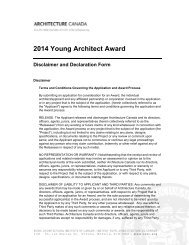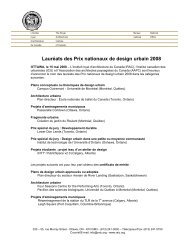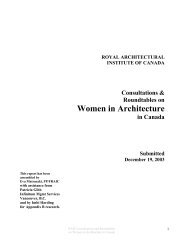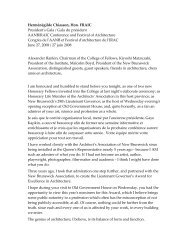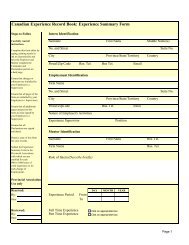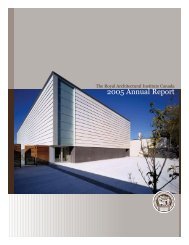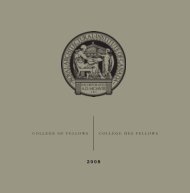Benchmark Study on Green Buildings - Royal Architectural Institute ...
Benchmark Study on Green Buildings - Royal Architectural Institute ...
Benchmark Study on Green Buildings - Royal Architectural Institute ...
You also want an ePaper? Increase the reach of your titles
YUMPU automatically turns print PDFs into web optimized ePapers that Google loves.
Even in world-leading green building countries, there are very few programs and<br />
initiatives that focus <strong>on</strong> waste minimizati<strong>on</strong>, resource management (other than energy, so<br />
water, building materials, etc.), site selecti<strong>on</strong> and maintenance, management of<br />
stormwater, relati<strong>on</strong>ship to local transportati<strong>on</strong> initiatives, etc. So, to maximize green<br />
building adopti<strong>on</strong>, programs and incentives should be offered wherever possible, should<br />
focus specifically <strong>on</strong> green buildings and green technologies, and should be diversified to<br />
offer support over the entire spectrum of green building areas.<br />
Programs covering aspects of green building other than energy efficiency include Keep<br />
Australia Beautiful’s (KAB) Clean Site Program which provides building industry<br />
professi<strong>on</strong>als with envir<strong>on</strong>mental guidelines focusing <strong>on</strong> erosi<strong>on</strong> and sediment c<strong>on</strong>trol,<br />
waste management and resource c<strong>on</strong>servati<strong>on</strong>. The Program also focuses <strong>on</strong> maintaining<br />
the overall envir<strong>on</strong>mental quality of the building site throughout the building period, with<br />
particular emphasis <strong>on</strong> minimizing negative effects <strong>on</strong> local waterways, rivers, creeks and<br />
beaches, which can experience significant increases in polluti<strong>on</strong> and sediment load during<br />
and after the c<strong>on</strong>structi<strong>on</strong> phases. Another n<strong>on</strong>-energy green building initiative is how the<br />
German and Japanese Governments are incorporating sustainability into their public<br />
educati<strong>on</strong> systems, and how they are running public awareness campaigns and open<br />
educati<strong>on</strong>al workshops to increase public knowledge of green building and sustainability.<br />
A final noteworthy green building initiative that is not energy-related is the UK’s<br />
Waterwise Program, which was launched to promote water efficiency. The Program<br />
recognizes that the key to water efficiency is in reducing waste, not restricting use, and<br />
has focused its efforts to reduce the amount of wasted water in the UK. These efforts<br />
have included repairing over 270,000 leaking supply pipes, distributing over 2 milli<strong>on</strong><br />
cistern devices (which reduce the unnecessarily high amount of water used in toilet<br />
flushing), and the provisi<strong>on</strong> of 15 milli<strong>on</strong> self-audit packs to help customers take steps<br />
themselves to use water more efficiently. The Waterwise website also has a water saving<br />
tips and a list of water saving products.<br />
Governments should begin offering rebates for the purchase, installati<strong>on</strong> and use of<br />
Energy Star Appliances and labeled energy or water efficient products. This is d<strong>on</strong>e in<br />
several of the countries reviewed (including in certain provinces in Canada), and has<br />
increased the use of these efficient products. These rebates can be small, to simply<br />
encourage the original purchase, because often these efficient products are slightly more<br />
expensive upfr<strong>on</strong>t, but save m<strong>on</strong>ey over time through their efficiency and c<strong>on</strong>servati<strong>on</strong><br />
levels. Rebates should be made available <strong>on</strong> appliances for homeowners, but also <strong>on</strong><br />
efficient building materials to encourage builders and developers to use efficient products<br />
during c<strong>on</strong>structi<strong>on</strong>. Additi<strong>on</strong>ally, groups in some of the other countries studied simply<br />
give out small products such as water-saving showerheads and energy efficient light<br />
bulbs for free, because so much water and energy can be saved over time for each<br />
comparatively cheap product given away. The savings made by society vastly outweigh<br />
the costs felt by the d<strong>on</strong>ating groups.<br />
Building codes and requirements denote the minimum standards developers must adhere<br />
to in order to legally create a building in a given country. Outdated standards are<br />
sometimes cited as hindering the development of green buildings because they can<br />
29



